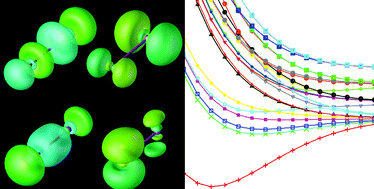Ab initio investigation of potential energy curves of the 23 electronic states of IBr correlating to neutral 2P atoms
Abstract
Potential energy surfaces for all Born–Oppenheimer electronic states of IBr molecule correlating to the neutral 2P (2P3/2 and 2P1/2) iodine and bromine are calculated for the first time. Electric dipole and polarizability curves (static and transition) are also determined. Calculations include scalar and spin–orbit relativistic effects within all-electron Douglas-Kroll two-component Hamiltonian. Electron correlation is treated with quasi-degenerate multi-reference second-order perturbation theory. Seven adiabatic electronic states (X 1Σ+, A′ 3Π2, A 3Π1, 1 3Π0−, B 3Π0+, B′ 3Σ−0+, and 2 3Π0+) exhibit significant covalent bonding, and can support vibrational states. Calculated spectroscopic parameters agree with experiment to better than 1000 cm−1 (Te), 10 cm−1 (ωe), and 0.05 Å (re). A new 1 3Π0− state correlating to ground-state atoms is predicted at Te ≈ 14 000 cm−1, ωe ≈ 80 cm−1, and re ≈ 3.0 Å. The second new state (2 3Π0+) correlates to excited iodine atom, with Te ≈ 20 000 cm−1, ωe ≈ 115 cm−1, and re ≈ 3.3 Å. Non-adiabatic coupling parameters are calculated for the four avoided crossings, which arise due to electronic spin–orbit interaction. Estimated parameters of the B 3Π0+/B′ 3Σ−0+ crossing (Rc ≈ 3.32 Å; V ≈ 120 cm−1) agree with experimental values. The previously unsuspected 2 3Π0−/1 1Σ− crossing of two repulsive surfaces provides a new collisional deactivation channel for Br* atoms at relative velocities above 1000 m s−1. Several repulsive states (including 1 1Π1 and 2 3Π1) intersect the B/B′ system near the avoided crossing point, and may affect dynamics of IBr in strong laser fields.


 Please wait while we load your content...
Please wait while we load your content...